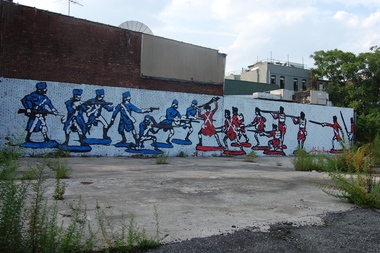
GOWANUS — The journal of a 19th century Gowanus farmer could further complicate plans to erect a pre-K school with suggestions that the site — already long-suspected of containing remains of Battle of Brooklyn soldiers — might also be the final resting place of slaves, the New York Times first reported.
The city announced plans to build an 180-seat pre-K at 201 Ninth St. between Third and Fourth avenues in 2015. But some local historians believe the site to be the burial ground of the legendary Maryland 400 — most of whom died Aug. 27 in 1776 fending off British troops long enough to allow Gen. George Washington and his troops to retreat to Manhattan.
Now the diary of Adriance Van Brunt, who owned a farm on the contested land, has resurfaced with details on the burial of slaves and others potentially on the lot.
The content could be a catalyst for a more extensive archaeological dig on the sacred ground, said one local historian who has long advocated for the land to include a Maryland 400 memorial.
"It really could be a game changer," said Bob Furman. "The difference now is that slavery is a much more potent issue politically than the Marylanders, for better or for worse."
Diary entries reviewed by The New York Times describe the burial of slaves including a 12-year-old named Nancy. The journal also mentions Van Brunt's relatives and others laid to rest on the farmland.
The lot's potential for graves and artifacts prompted the state's Office of Parks, Recreation and Historic Preservation to order the city's School Construction Authority conduct a June dig at the site.
Remains have not been found so far, but the state requested more data before making a recommendation to the city on whether or not to build. That report is expected to land on the School Construction Authority's desk later this year, according to Ben Goodman, the agency's community relations manager.
But some — including Furman — believe the dig, which varied from three to six feet in some spots and did not span the entire lot, was not deep enough to pierce through landfill and reach earth where graves are more likely to be discovered.
For Furman, the diary puts that argument to bed — confirming the need for a comprehensive investigation of the grounds.
"I think this will absolutely cause them to dig deeper," said Furman. "This whole thing has been documentation dependent, now that there is more evidence slaves could be buried in the area that sets off a whole chain."
The diary corroborates another historical account of slaves buried on the land, but the burial ground's exact location is still up for debate.
Consultants investigating the area found mention of the Van Brunt family cemetery in deeds as the property flipped over the years, but the graves' exact locations are unknown. At the time it was common practice for families to keep a second cemetery for burying slaves — it is also unclear if that is the case for the Van Brunts.
The family was among the surge of Brooklynites who moved their burial plots to Green-Wood Cemetery during the 1840s and '50s. If slaves were buried on the Gowanus farm, they likely remain because it was not common to relocate the remains of slaves, according to the historian at Green-Wood Cemetery.
"The normal practice was to move blood relatives, but slaves were typically left behind," said Jeff Richman. "There’s certainly an argument to be made that individuals would have been buried there."
In fact, the neighborhood is likely scattered with remains from the Revolutionary War when the practice was to bury soldiers on the battlefield, explained the executive director of Park Slope's historic Old Stone House.
"What lies beneath us is largely unknown," said Kim Maier. "There’s not going to be a formal burial site, there is some record keeping, but in terms of the American dead it’s likely they were buried where they fell."
Historians believe remains may be beneath the Staples on 348 Fourth Ave. between Third and Sixth streets and could even be dredged up during the Gowanus Canal's Superfund cleanup since the waterway was the main escape route from the area, according to Maier.
Only a thorough archaeological survey will lay suspicious to rest, but the mounting historical pressure on the land may eventually cause the city to back off, said Furman.
"At a certain point, it becomes so powerful an issue that government agencies will say, 'You know, there’s too much going on here,'" said Furman. "And that could happen here. We'll have to wait and see."
READ MORE:
► Before Battle of Brooklyn, Invasion Started in Staten Island
► Crown Heights Back Alley Nearly Lost to History Recalls Colonial Retreat
► Cobble Hill Trader Joe's Was Site of Despair for Washington in 1776
► Legend of Murray Hill Tea Party Persists 240 Years After Battle of Brooklyn

















